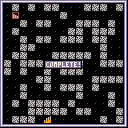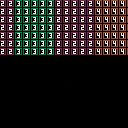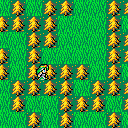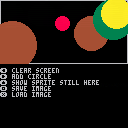
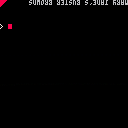
cls()
print"mary jane's buster browns"
-- 0=using memcpy()
-- 1=using standard array
kind=1
if kind==0 then
memcpy(0,24576,320)
color(0)
rectfill(0,0,127,5)
color(7)
sspr(0,0,128,5,0,0,128,5,true,true)
reload(0,0,320)
sspr(0,0,8,8,0,0,8,8)
print("",0,24)
stop()
end
rev={}
for i=0,4 do
rev[i]={}
for j=0,127 do
rev[i][j]=pget(j,i)
end
end
for i=0,4 do
for j=0,127 do
pset(127-j,4-i,rev[i][j])
end
end
rev=nil
spr(0,0)
print("",0,24)
|
What makes programming interesting is the many different ways in which you can approach a problem.
I'm trying to understand PICO-8's method of NOT seeding a random number, that is, I want to return back to the original seed after I have seeded a number
cls() z=rnd() srand(1) ?"" ?"forced seed" ?rnd() ?rnd() ?"" ?"reset to random seed" srand(z) ?rnd() ?rnd() |
The only way I know how to do it is this. Get a random number to begin with. Seed the number I want, get the values for this forced seed, then return back by seeding with the initial random number. But isn't there a way to reset the SRAND itself ?
In Blitz for instance, you seed (-1) to return it back to normal non-seeded random numbers, but that does not work here.
Hello, I am back for a bit, maybe longer, depending on circumstances. Mostly I am programming in BlitzMAX though.
However, I have since come across a program that lets you run LUA in the Pocket Sony Playstation device.
Since PICO-8 is LUA, is it possible to run PICO-8 on PSP then, as an ISO or CSO ?
The emulator PPSSPP which runs PSP flawlessly is for Android, Windows, iOS, macOS, Blackberry, Meego/Harmattan, Symbian, Pandora, and Linux.
https://www.ppsspp.org/downloads.html
One major advantage of running PICO-8 on the PSP is with PPSSPP you can state-save and state-load. That will definitely be helpful to gamers.
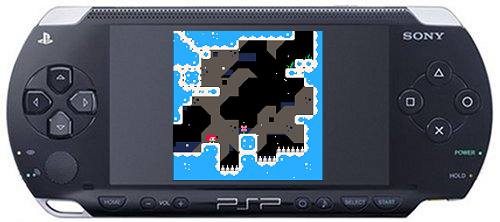
As the resolution of the PSP is 480x272, the screen of 128x128 could be scaled and dithered to 272x272 or 362x272 for a 4x3 proportion.
And it would look great.
So how about it, can it be done ?
Can you do it ?
This is much along the same lines as Gembit's remarkable game, "Eternal Tower" HERE:
https://www.lexaloffle.com/bbs/?tid=32173
and Polyphonic's random map generator HERE:
https://www.lexaloffle.com/bbs/?tid=32237
I've always wanted to write the code to a cavern maker where literally each wall is randomly placed and then checked to ensure that the areas around it can be reached.
And now you can ! Guarantees that all points can be reached despite the placement of the walls.
Change DEBUG in beginning to:
0 = Only draw completion
1 = Show the walls being drawn (default)
2 = Show the scanning process for each wall
Running into a bug, let me leave the stairs off for now. Should still run fine.
Got it fixed, should be alright now.



UPDATED 11-08-18 (11:45am)
Years ago when I started writing business software for the IBM, I rarely ever used the mouse, thinking it to be slow and cumbersome. And as such, I would often write a little sparkle routine should you ever press down the button and drag it across the screen. And back then screens were 640x480 so the glitter was really quite pretty at its tiny size.
I never actually sat down just to write this glitter method all by itself, until now.
The code I wrote years ago would sparkle where the mouse is when the button was pressed, then fade, showing the business app beneath. This particular version is actually one you can draw pictures in with. Young kids and those young at heart might really enjoy doing this.
Use the mouse, press the LEFT button to draw a "glitterific" line or plot.
To test it, try writing the first 4-letters of your name, or maybe a symbol like a heart or diamond.
Press (X) to animate the glitter.
Hold (O) to slowly erase the glitter so you can start a new picture.
Change DEBUG=0 to turn off the number counters at the top.
If you like, post some of your own glitterific pictures to show the world.
Enjoy !
Below is original version:



Scrub and me were just messing around, taking a bit of a break from Paint. He thought it would be interesting for us to write a topview Minecraft in Pico. I took it to mean it would be on a dot level and wrote some code to randomly create colors on the screen, bricks to build with.
But when you take out the colors and mirror the screen, you get a very nice Rorschach Test image.
https://en.wikipedia.org/wiki/Rorschach_test
NOTE: Every test picture has exactly 1001 pixels, no more, no less ! (or 2002 if you count the mirror).
What do you see ?
Post some of your favorites if you like and tell us what you think it is !


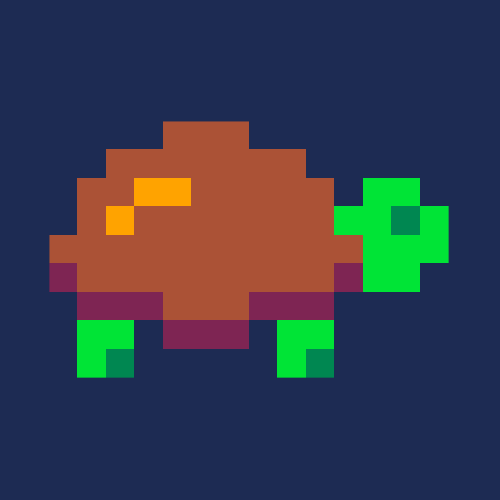
Because 7 ate 9.
No, seriously, why is color #6 so close to color #7 ?
I mean, if you look at the decimal values for the three colors of 5, 6, and 7, you have:
N .. Red . Grn . Blu 05 . 095 087 079 06 . 194 195 199 07 . 255 255 255 |
You can calculate what color #6 should be based on taking each of the color guns and subtracting the difference from 7 and 5 adding the division by 2.
You would get:
N .. Red . Grn . Blu 05 . 095 087 079 06 . 175 171 167 07 . 255 255 255 |
So why the disparity ? And why are "gray" not matched all across the board ? If you median them out, (adding the 3 together and dividing by 3), you would have:
N .. Red . Grn . Blu 05 . 087 087 087 06 . 171 171 171 07 . 255 255 255 |
So why the current color disparity between grays ?

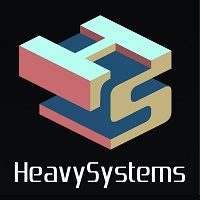
Very simple request really.
Wanted to know if there was a way to get the white noise in PICO to sound as deep as this.
And if not, can future PICO please ?
Also add optional instruments, use MIDI, which has 127.
So it should be possible to get some music like THIS, with the wind effect:
I know PICO is limited, but that music you are hearing now is from SNES which came out in 1990 so that's 28-years ago. Surely we can achieve at least the same level as SNES without affecting current code, SFX, or MUSIC.

Hello:
I recently came across this link trying to find a particular cart from PICO.
It's interesting in the fact it shows that in other programming languages capable of directly accessing the internet, you can load up PICO source code and elements.
https://www.lexaloffle.com/bbs/snippet.php?cart_id=57568&src=0
-- "fireflies" (10-05-18) ----- -- written by dw817 ----------- -- \138 standard pico-8 license - -- big props to remagamer for - -- human movement method ------ s=16 -- ^ speed of rotation -- lower = faster -- higher = slower n=128 -- ^ number of fireflies ring,ok,z,t,a,x,y=0,0,0,{},{},{},{} for i=0,n-1 do t[i]=0 x[i]=rnd()*128 y[i]=rnd()*128 a[i]=rnd()*360 end cls() repeat cls() if ring==1 then circ(64,64,8,2) circ(64,64,16) circ(64,64,24) end for i=0,n-1 do c=1 if t[i]>0 then t[i]-=1 c=10 if t[i]<4 then c=4 elseif t[i]<8 then c=9 end end pset(x[i],y[i],c) a[i]+=(rnd()*2)-1 h=x[i] v=y[i] x[i]+=cos(a[i]/s) y[i]+=sin(a[i]/s) ok=0 if pget(x[i],y[i])>0 and (abs(flr(x[i])-flr(h))>=1 or abs(flr(y[i])-flr(v))>=1) then ok=1 end if x[i]<0 or x[i]>127 or y[i]<0 or y[i]>127 or ok==1 then if (ok==0) a[i]=rnd()*360 x[i]=h y[i]=v if (ok==1) t[i]=16 end if (x[i]<0) x[i]=0 if (x[i]>127) x[i]=127 if (y[i]<0) y[i]=0 if (y[i]>127) y[i]=127 end if (btnp(5)) ring=1-ring if (btn(4)==false) flip() until forever
|

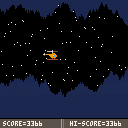
TO LOAD THIS CART in immediate mode, type:
load #helicopter
WHAT'S NEW ??
-- written (10-15-18) --------- -- time to code: 2+hours ------ -- what's new ?? -------------- -- 03-06-22 -- + hiscore was not being -- saved during normal -- flight. it is now. -- 10-17-18 -- + tricky, got the color of -- the board to change only -- if truly achieving 1000 -- pts. can't decrease score -- to flip it again. -- + changed the "collision" -- check to be right ahead of -- the helicopter instead of -- below or above - more -- margin to wiggle in. -- + fixed the "impossible" -- corridors. should always -- be able to fit between no -- matter how high the level. -- + added a launch pad for the -- helicopter to take off -- from. -- 10-16-18 -- + must earn 1000 points for -- bonus color + corridor -- reset. -- + added horizontal level -- try to keep in center for -- stability in flight. -- + added descend (X) key -- costs 10-points each -- frame. -- 10-15-18 -- + scaled down collision -- check is now in place. |



Alright. Sometimes to improve on something you have to redo the whole thing from scratch. That's what I did here and with workable results.
Now I know PICO is capable of more keystrokes than the simple Left, Right, Up, Down, (O), and (X).
But for purists who don't want to dabble with 2- or 3-player controls, there is this.
It's very good for what it does. It can read keystrokes, and by that I mean layered. You can be pressing 3-buttons down at a time and it will still recognize a unique 4th. It's that powerful. Let's go over it.
You have one string to get things going called, "KEYTYPE." It's a string and contains 6-characters which tell the state of reading for the keys in this order [Left, Right, Up, Down, (O), and (X). I.E:


Years ago I was with my Dad and the MENSA group watching fireworks. There were people all around, it was busy busy, smells of gunpowder and good food were all around.
Everyone was talking noisily and you can hear car radios playing as some sat on top of their vehicle to get a better look.
Right then though, I worried about something. Strange that I would with all the good things and fun around me.
I went to my sister who was sitting on the grass watching the sky.
"What is it ?" she said.
"Where are all the fireflies ?" I asked her.
"Fireflies ?" She looked up and around. "There's no fireflies here. There's no firework called a 'firefly' that I know of."
I pressed the issue, "No, I don't see any fireflies - at all - anymore. Where have they gone ? Are they all in the arctic now ?"
She smiled, "No, you won't have to travel that far to find them." She took a sip of her soda. Looked around, then said, "Come on. I'll show you some."
With that she took a direction completely away from all the activity. Then she ducked into several bushes and kept on. I was afraid we would get lost but I followed her anyways. The bushes were getting thicker and more tangled when suddenly ...
"We're here." she whispered.
"What ?"
She repeated, "Right here, dummy. Take a look."
Somehow, I don't know how I couldn't even hear the fireworks or noise or anything. Only a few crickets chirping. We were in an opening in a huge bush, enough room for only two people, her and me.
And there they were.
Fireflies.
All flitting about and each other, lighting up if they bumped into one another.
For a long time I couldn't say anything. I looked to her and she grinned.
Finally she spoke, "Cities have just about driven them out, but you can still find them - if you can find still and quiet places like these. I know this territory and I've been here before."
We watched a few more minutes. She stood up, "Ready to go ?"
I nodded, "Yeah. And - thanks."
"Sure thing." she smiled, and we went back to where Dad and MENSA was to watch more fireworks.
Now these fireflies have a little bonus. They have what I call the, "Friendship Ring." You can turn it on and off with the (X) key. They love the ring and will stay on it, lighting up to show their interest.
To speed up the fireflies, press the (O) key.
Open source to change rotation speed of fireflies and how many there are.
Big props and thanks go to "Remagamer" who with his code showed me a unique way to move an object, by direction and rotation. You can find his amazing cart HERE:
https://www.lexaloffle.com/bbs/?tid=31995
Be certain to give him a star because that's what makes sharing code really interesting is when someone can understand it and apply what they've learned, extending and commending on that intelligent concept or code.



I have always been a fervent believer of backtracking in technology to learn or experience something that may not be at all available today or even available at all in the future.
Recently I was thinking, is it possible. Can it be done ? HOW would it be done ? To build a fully-working and useful 4-bit assembler ?
That is, a fantasy console that uses only 16-commands and is a fully working and useful computer.
My idea was that it would have a 16x16 pixeled screen, B&W, 8-colored lights, a 3-digit LED - red on the left, green on the right. And can read and react to standard input, U D L R A B, either waiting for the key or strobing it.
Now I might be able to lay out memory. You have only 256-bytes to work in.
The top 32-bytes are reserved to display 8 4-character messages (A-Z, 0-9, etc) where the font is small: 3x5, which could further be displayed by one of the 16-commands available to the 4-bit processor.
You also have a PINK and GREEN pixel overlaying the 16-B&W. These are to be treated as individual sprites. So you cannot have more than one PINK or GREEN pixel at a time. You can hide one or the other, but only their LOCATION is recorded.
The 16x16 B&W screen is a true 32-bytes, so here is the memory layout so far:
[code]






While I don't have any immediate plans for a mapper myself, a great many of you out there do. And that's construction work that could be made easier with this cart.
For this is not only a mapper creator and editor, it also has an in-board function quite similar to the MAP() routine - with the unique exception instead of reading the mapper memory, it reads a single string which contains the size of the map its edges, bits of other data, and the actual mapper data itself.
use import {image}.png to import your own 256-character tile/sprite set to use in the mapper.
Commands follow:
Hold (Z) key to bypass logo.
If you are creating a new map, you will have a very small input routine active.
Use the LEFT and RIGHT arrow keys to navigate by 1-character.
Use the UP and DOWN arrow keys to navigate by 3-characters.
Press (O) to type that character.
Press (X) or have the key select on "<" to erase the last typed character.
Have the key select on ">" to accept that input.
At this time NAME OF MAP is not being used or even recorded. I just put it there to test the input routine, you can skip it by selecting the ">" key.
In editor, tap (X) to do three things. One, change keyboard mode to four. Nice delays and speed, no increase with repeat. Two is select the tile beneath the cursor. Three is you will have an option of selecting any of the 256-sprites to draw on the map, but the cursor initially starts on the last tile you had highlighted back in the editor.
Press (O) to select that sprite/tile. (X) to cancel.
In editor, tap (O) to plot that tile/sprite.
Use arrow keys to scroll. If you choose an area that is bigger than the screen, it will scroll to reveal it.
Press both LEFT and RIGHT to see a demo of the Map-player. Use arrow keys to navigate. Use this function, DRAWMAP() in your code.
The function DRAWMAP() can be used directly in your own code. These are the arguments for it.
DRAWMAP (T,H,V,X,Y,DX,DY) T ... ( Map itself, a text string created from this program , H ... the horizontal position to plot on the screen , V ... the vertical position to plot on the screen , X ... the size across to plot the map on the screen , Y ... the size down to plot the map on the screen , DX ... the starting position (top-left LEFT corner) of the map contents to draw , DY ... the starting position (top-left TOP corner) of the map contents to draw ) |
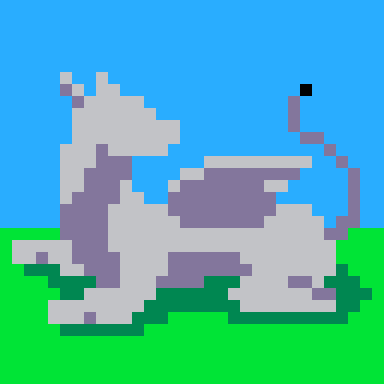

As far back as I can remember, any routine that used Boolean could be evaluated not only as TRUE and FALSE but also zero (0) and (1) or minus one (-1).
Strangely you cannot do this in Pico-8. I'm wondering if there is a reason for this as it would be a simple matter to make global definitions of TRUE to equal 1 and FALSE to equal 0. A conditional statement without an argument would simply be any non-zero number.
if (apple) takeabite() |
So this would evaluate true provided the variable apple, boolean or otherwise, evaluated to any number besides zero.
For that matter I am understanding that SGN(0) also reveals 1 whereas all other programming languages I've known show it to be zero. What is the reason for these identities and lack thereof ?
Now NIL is a special case and I kind of understand why it exists. It says that this item has not been defined. Not that it equals zero or empty string of "" ... no, simply NIL. Yet when attempting to evaluate NIL as being less than 1 or equal to zero or less than an empty string of "" or equal to that selfsame empty string "", you get a type mismatch error.
And maybe for NIL, this is a good idea. What are your thoughts on these logical and functional operators ?



TO LOAD THIS CART in Pico-8, in immediate mode type:
load #pc |
UPDATED: 12-28-19
Saving all SRAM now. CSTORE() RELOAD()
Despite the setback of not being able to retain all the sprite images with 8192-bytes of data (the full-screen), you can certainly save 4096-bytes and still retain a good 128 of 8x8 pixels sprite data.
In this program, press LEFT to clear the screen.
RIGHT to add a random colored circle in the recorded screen area.
UP to confirm the sprite area is not overwritten (top 128 sprites).
(O) to save off that screen area.
(X) to load it back. Try rebooting and loading only to confirm it is recorded.






 0 comments
0 comments
